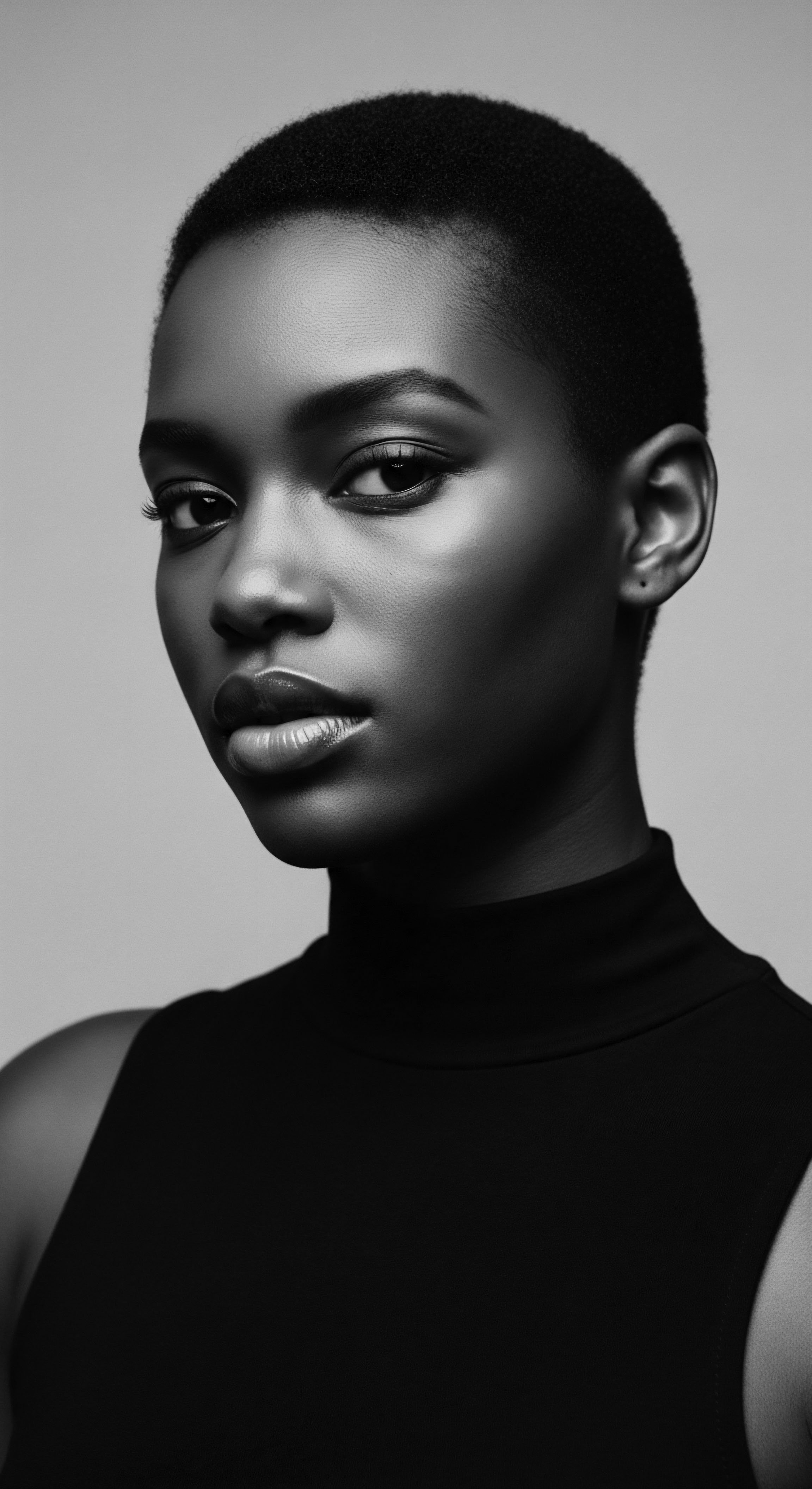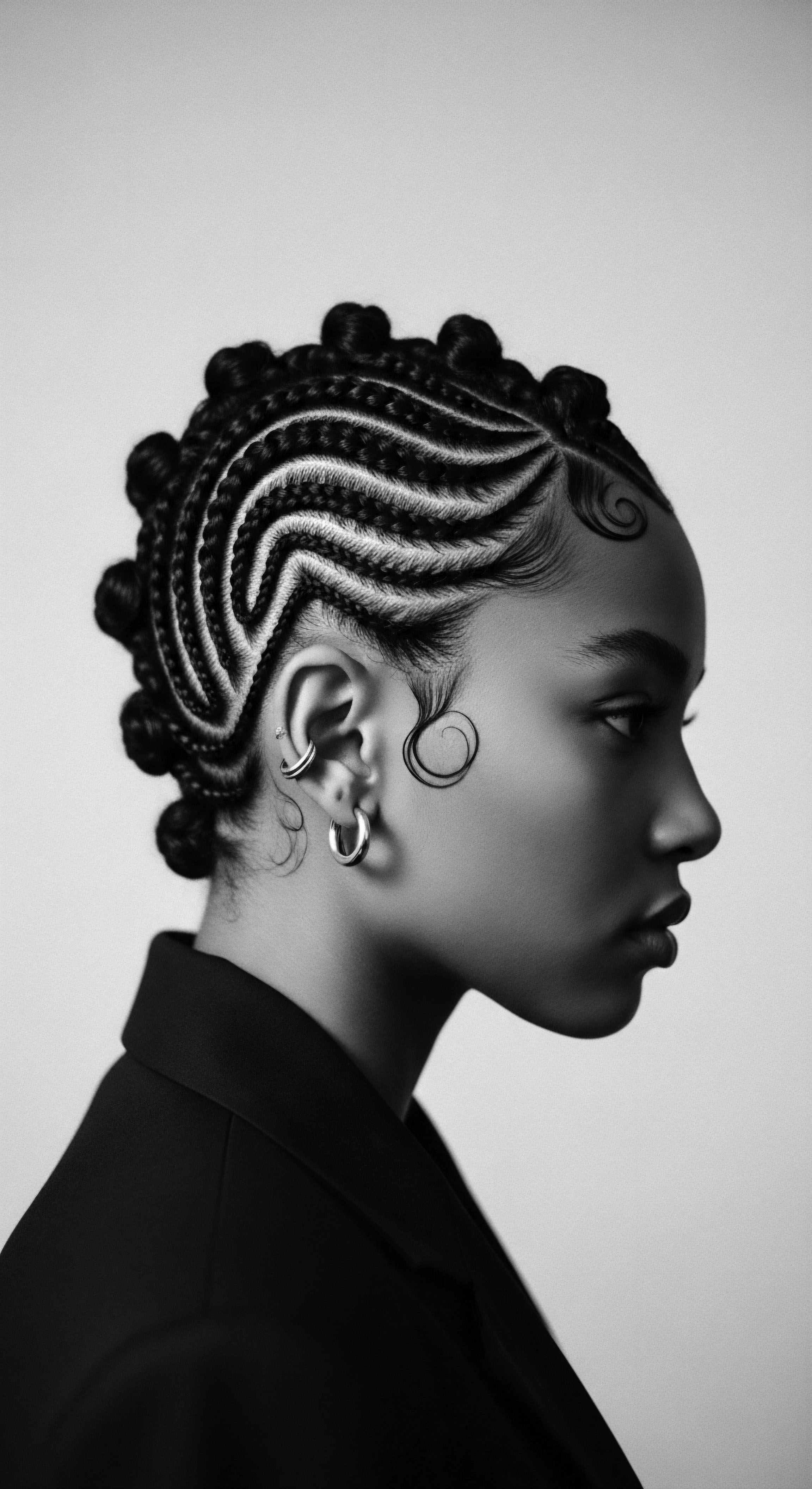
Fundamentals
The period following the formal cessation of chattel slavery in the United States brought forth a transformative epoch, birthing what we now recognize as the Emancipation Era Identity. This designation refers not merely to a chronological marker, but rather to the profound internal and external redefinition that individuals of African descent undertook as they navigated newfound, albeit often circumscribed, freedoms. It represents a fundamental shift in self-perception, a deliberate casting off of the enforced anonymity and dehumanization of enslavement, and a conscious forging of a collective and individual sense of being in a world ostensibly remade. This period, stretching beyond the immediate legal declaration, speaks to the ongoing struggle for autonomy, dignity, and cultural re-affirmation that echoed through generations.
Central to this profound re-ordering of self and community was the deeply personal and often public declaration of one’s body, particularly textured hair, as a site of self-sovereignty. For centuries, enslaved people’s hair had been subjected to brutal neglect, forced styles, or even deliberate disfigurement as tools of control and degradation. Hair, an elemental biological feature, became a battleground for identity.
The Emancipation Era Identity, therefore, began with the elemental act of choosing ❉ choosing how to present one’s hair, choosing to care for it, and choosing to reclaim it as an integral part of one’s spiritual and corporeal being. This initial step, seemingly small, held immense psychological and social weight.
The Emancipation Era Identity signifies a pivotal redefinition of self and community for individuals of African descent, with textured hair becoming a profound canvas for newly found freedom and self-determination.

Echoes from the Source ❉ Hair’s Ancient Roots and Reawakening
Even amidst the unimaginable brutalities of the transatlantic slave trade, ancestral hair practices, carried across the Middle Passage in memory and spirit, persisted. These traditions, passed down through generations of forced labor and clandestine gatherings, represent the true “Echoes from the Source.” They were the whispered secrets of plant lore, the rhythmic motion of braiding under moonlight, the shared knowledge of nourishment from the earth. The Emancipation Era did not create these practices anew; rather, it provided the first widespread opportunity for their open, collective re-expression. Women and men, emerging from bondage, sought to reconnect with these deep traditions, transforming what was once a furtive act into a public statement of heritage.
The rudimentary tools and ingredients available to newly freed people—natural oils rendered from animal fat or plants, handmade combs, thread—were employed with a wisdom born of necessity and ancestral memory. This period saw the informal revival of braiding circles, communal wash days, and the sharing of knowledge about scalp health and strand resilience. These were not mere cosmetic routines; they were rites of passage, communal healing sessions, and tangible links to a past violently severed yet never fully extinguished. The tactile sensation of hands working through coils and kinks, the fragrant oils, the stories exchanged—all contributed to the repair of a fractured identity, piece by piece.
The understanding of hair’s resilience, its capacity for growth and self-renewal, became a powerful metaphor for the journey of Black people themselves. Each strand, in its unique curl and strength, bore witness to survival. Emancipation Era Identity thus found one of its earliest and most visually striking expressions in the deliberate cultivation and styling of textured hair, a reclamation of innate beauty and a profound connection to an enduring lineage. It was a silent, yet potent, defiance.

Intermediate
Moving beyond the foundational understanding, the Emancipation Era Identity unfolds as a complex tapestry woven from threads of newfound agency, cultural reconstruction, and burgeoning economic independence. This period extended past the immediate aftermath of legal freedom, stretching into the early twentieth century, as formerly enslaved people and their descendants actively built communities, institutions, and a collective sense of self. The significance of textured hair during this era transcended mere aesthetics; it became a tangible marker of identity, a canvas for self-expression, and a testament to resilience amidst persistent societal challenges.

The Tender Thread ❉ Hair Care as Community and Economic Sovereignty
The act of hair care during the Emancipation Era transformed into a deeply communal and empowering practice, truly embodying “The Tender Thread” of shared experience. As Black communities began to coalesce and establish their own social structures, hair care became an intimate ritual shared within families and neighborhoods. It was a space for intergenerational exchange, where elders imparted wisdom about natural remedies, styling techniques, and the cultural meaning of various coiffures to younger generations. These gatherings, often informal, served as crucial sites for reinforcing familial bonds and collective memory, fortifying identity against external pressures.
The demand for appropriate hair care products and services within these communities also spurred a wave of entrepreneurship. With mainstream markets largely ignoring the specific needs of textured hair, Black women stepped forward, often out of sheer necessity, to fill this void. This period witnessed the genesis of an independent Black beauty industry, a remarkable feat of self-determination. These pioneering entrepreneurs, often former domestic workers or laundresses, leveraged their intimate knowledge of hair and herbal remedies to create specialized conditioners, pomades, and styling aids.
Hair care during the Emancipation Era evolved into a powerful symbol of community solidarity and economic self-determination, sparking an independent Black beauty industry.
One compelling historical narrative that brings this to life is the emergence of Sarah Spencer Washington, a figure less commonly celebrated than some contemporaries, yet deeply significant to the practical application of Emancipation Era Identity in the realm of hair. Born in 1889, her life bridged the Emancipation Era’s immediate legacy and the dawn of the Harlem Renaissance. Washington founded the Apex News and Hair Company in 1919 in Atlantic City, New Jersey. Her distinct approach recognized that empowering Black women through hair care was not just about superficial appearance; it was about providing avenues for economic stability and self-sufficiency for thousands.
While others focused on products, Washington built an empire around education and franchise. She established beauty schools and licensed cosmetologists, creating a network of independent Black businesswomen. This was a profound act of economic agency, directly reflecting the spirit of the Emancipation Era. The Apex system offered not just products but a pathway to self-employment, allowing Black women to escape exploitative labor and establish their own economic destinies.
Her legacy extends to the thousands of Black women who found dignity and financial freedom through her Apex beauty colleges and network, showcasing how hair care was a conduit for broad social and economic advancement. (Harris, 1998). This is not merely an anecdote; it speaks to the fundamental shift in the significance of hair, transforming from a site of oppression into a wellspring of opportunity and self-possession.

The Economics of Hair ❉ From Subsistence to Enterprise
The business of hair care, born from a deep understanding of unique hair needs, became a potent symbol of agency and economic independence for Black communities during and after emancipation. This was a direct response to the systemic exclusion from existing economic structures. Hair-related enterprises provided employment, fostered self-reliance, and circulated capital within Black communities, laying foundational stones for future generations. The simple act of purchasing hair grease from a Black woman entrepreneur, or getting one’s hair pressed by a skilled beautician in a local parlor, affirmed a shared sense of community and reinforced economic networks that circumvented oppressive mainstream systems.
The skills associated with hair styling and product creation were often honed in informal settings, passed from one set of hands to another. These skills were practical, immediate, and offered a tangible path to earning a living.
- Hair Pressing ❉ A technique using heated metal combs to straighten textured hair, widely adopted for its immediate transformative effect and its ability to conform to prevailing beauty standards, while still retaining a connection to the hair’s natural form.
- Homemade Remedies ❉ Formulas combining natural oils, herbs, and other readily available ingredients for conditioning and styling, reflecting ancestral wisdom and resourcefulness.
- Braiding and Plaiting ❉ Traditional styling methods that were re-contextualized for everyday wear and special occasions, often incorporating intricate patterns that held cultural significance.
- Wigs and Hairpieces ❉ Employed both for stylistic reasons and for practical purposes, offering versatility and protecting natural hair, drawing on ancient African traditions of hair adornment.

Academic
The Emancipation Era Identity, when rigorously examined through an academic lens, emerges as a profoundly complex socio-cultural construct. It signifies the dynamic process through which formerly enslaved African people and their descendants collectively and individually negotiated, articulated, and solidified their post-slavery subjectivities. This complex meaning extends far beyond mere legal freedom, encompassing a re-assertion of humanity, agency, and cultural heritage that had been systematically denied. Scholars consider it a period of foundational self-making, where the meaning of Blackness in America was continuously contested and redefined, with textured hair practices standing as significant, often underestimated, markers within this re-designation.
From a sociological standpoint, the period saw the strategic deployment of hair as a form of social commentary and communal solidarity. The reclamation of diverse hair textures and styles, or the deliberate choice to adopt styles that mirrored Eurocentric aesthetics, were both distinct expressions of Emancipation Era Identity. The former represented a defiant embrace of inherent Black beauty and ancestral connections, while the latter often served as a pragmatic survival strategy or a pursuit of upward mobility in a deeply segregated society. Both, however, were acts of conscious choice within a restrictive framework, signifying a measure of autonomy previously unimaginable.

The Psycho-Social Contours of Hair and Self-Definition
The psychological ramifications of hair on identity during this epoch are extensive. Enslavement had systematically stripped individuals of their personal identity, often through methods that included the deliberate neglect or forced uniformity of hair. The act of tending to one’s own hair, of choosing its presentation, became a deeply therapeutic and affirming practice.
It was a tangible way to assert ownership over one’s body, a physical manifestation of newly claimed selfhood. The care rituals themselves fostered a sense of self-worth and communal bonding that contributed to psychological resilience in the face of ongoing racial discrimination.
Consider the critical role of the Black Press during this era in shaping perceptions of Black beauty and identity. Publications like The Colored American Magazine and The Crisis, while often featuring advertisements for straightening products, also presented diverse images of Black people and discussed topics of racial uplift and self-respect. They became forums where the meaning of Emancipation Era Identity was debated and solidified, often with hair imagery playing a subtle, yet powerful, role in these visual narratives. The juxtaposition of various hair presentations in these publications reflects the complex negotiations of identity during this time—the pursuit of social acceptance alongside the quiet assertion of cultural distinctiveness.
Academically, the hair journey during the Emancipation Era presents a compelling case study in the intersection of biology, culture, and power. The unique helical structure of textured hair, its distinct hydration needs, and its capacity for diverse styling were gradually understood, not through formal scientific inquiry initially, but through generations of inherited practical knowledge. The development of specialized products, as observed with entrepreneurs like Sarah Spencer Washington, represented an indigenous scientific innovation, validating ancestral methods through empirical, if informal, observation.
Emancipation Era Identity, academically understood, reveals hair as a dynamic marker of self-determination, reflecting complex negotiations between cultural affirmation and societal adaptation.

The Unbound Helix ❉ Hair as a Voice for Identity and Future Building
The “Unbound Helix” speaks to the inherent freedom and adaptability of textured hair, mirroring the aspirations of a people breaking free from bondage. Hair became a profound vehicle for voicing identity and shaping future trajectories for individuals and communities. The choices made about hair—whether to retain its natural curl, to straighten it for conformity, or to adorn it in elaborate ways—were not superficial.
They were declarations of aspiration, resistance, or adaptation within the newly defined social order. This was a language spoken not just in words, but in texture, style, and presentation.
The long-term consequences of these Emancipation Era hair practices extend into contemporary conversations about natural hair movements, cultural appreciation, and racial identity. The foundations laid during this period, through the establishment of independent beauty enterprises and the valuing of traditional care practices, continue to resonate. The very notion of “good hair” or “bad hair,” deeply entrenched in the colonial legacy, was actively, though not always uniformly, challenged by the assertion of Black beauty standards born from this era. This ongoing dialogue is a direct descendant of the choices and challenges faced by those who first grappled with the meaning of Emancipation Era Identity.
Moreover, the cultural significance of hair transcended individual choice to become a communal symbol. The care and styling of hair were communal acts, fostering social cohesion and shared purpose. Hair served as a visual reminder of collective journey, a story etched in every braid and coil.
To illustrate the continuity and cultural transfer of this identity, consider the Specific Historical Example of Hair Braiding Schools and Independent Beauticians in Reconstruction-Era Southern Cities, particularly figures like “Madame” Sara Spencer Washington and the broader network she represents, rather than just well-known figures like Madam C.J. Walker. While Walker’s empire was significant, Washington’s focus on beauty colleges provided a structured pathway to economic liberation for countless Black women, embodying the Emancipation Era Identity in a concrete way. As documented by historians such as Kathleen Thompson Hill, in her extensive work on early Black entrepreneurship, these schools provided not only vocational training but also a sense of dignity and community.
These institutions functioned as hubs for social organizing, informal education, and the sharing of ancestral hair knowledge, becoming micro-economies within larger segregated societies. The curricula, often developed by Black women themselves, included hygiene, chemistry (applied to product formulation), business management, and etiquette, all delivered with an underlying emphasis on racial uplift and self-respect. This system of vocational training was a direct and deliberate act of self-sufficiency, building economic ladders for women who had few other options. The graduates, equipped with skills and a professional network, returned to their communities, becoming pillars of local economies and further disseminating methods of care that honored textured hair.
This distributed economic empowerment, driven by the practical needs of hair care, represents a powerful, less-often-cited aspect of the Emancipation Era Identity ❉ a quiet revolution in the hands of women building their own futures. (Hill, 2007).
| Aspect of Hair Heritage Care Access & Autonomy |
| During Enslavement Limited to clandestine, makeshift methods; often neglected or forcibly shorn. |
| Post-Emancipation Era Increased access to resources; personal choice in styling and care; emergence of Black-owned salons. |
| Aspect of Hair Heritage Cultural Significance |
| During Enslavement Suppressed, forced assimilation; symbolic meaning often hidden or distorted. |
| Post-Emancipation Era Reclamation of ancestral styles as expressions of dignity, pride, and heritage; evolving standards of beauty. |
| Aspect of Hair Heritage Economic Dimension |
| During Enslavement No personal economic benefit; skills often exploited by enslavers. |
| Post-Emancipation Era Birth of Black beauty entrepreneurship; creation of jobs and wealth within communities. |
| Aspect of Hair Heritage Community Role |
| During Enslavement Shared discreetly in small groups, as a survival mechanism. |
| Post-Emancipation Era Hair care as communal ritual, social gathering, and a vehicle for cultural transmission. |
| Aspect of Hair Heritage This table reflects the profound shift in the function and meaning of textured hair, as it became a tangible expression of freedom and a cornerstone of community building during the Emancipation Era. |
The intricate understanding of how textured hair responds to different elements and care methods—knowledge that had been preserved through generations—found new avenues for application and commercialization. The very elemental biology of hair, with its unique structure, dictated specific care regimens.
The choices made about hair during this period were deeply intertwined with broader societal narratives of race, class, and gender. The natural hair movement of the 1960s and beyond, for example, draws a direct lineage from the seeds planted during the Emancipation Era, carrying forward the spirit of self-acceptance and cultural pride. This continuous thread illustrates the enduring power of hair as a cultural artifact, a living archive of a people’s journey toward self-determination.
The scholarly examination of Emancipation Era Identity through the lens of hair thus reveals a story not of simple freedom, but of the protracted, courageous, and deeply personal struggle for self-possession, economic empowerment, and the re-articulation of a vibrant cultural heritage. It underscores how what might seem a trivial aspect of appearance, in the context of profound historical shifts, can become a profoundly significant marker of liberation and identity.

Reflection on the Heritage of Emancipation Era Identity
The journey into the Emancipation Era Identity, seen through the intimate lens of textured hair, reveals an enduring legacy of resilience, innovation, and profound self-love. It is a heritage etched not just in historical texts, but in the very strands of our hair, in the inherited wisdom of our hands as we tend to it, and in the communal echoes of shared care rituals. The spirit of those who, emerging from the crucible of bondage, chose to reclaim their hair as a sacred part of their being, continues to inspire. Each coil, each kink, each wave tells a story of survival and triumph.
We are invited to consider our own hair journeys as continuations of this powerful ancestral narrative. The products we choose, the styles we wear, the very conversations we have about textured hair, all carry the resonance of those early declarations of self-ownership. It is a living archive, a testament to the strength that flows from honoring one’s origins. Understanding this historical context allows us to appreciate that hair care is not merely a routine; it is a ritual of connection, a way of communing with the profound wisdom passed down through generations.
The Emancipation Era Identity reminds us that true freedom extends beyond legal decrees to the deepest chambers of self-acceptance and cultural affirmation. It challenges us to look beyond fleeting trends and reconnect with the elemental practices and spiritual significance of hair. Our hair, indeed, is not merely a biological structure; it is a profound meditation on heritage, a living, breathing testament to the unbound spirit of our ancestors, and a guiding light for future expressions of identity. The soul of a strand carries the weight and glory of centuries.

References
- Harris, Leslie M. 1998. New York and the Rise of the Negro Press, 1890-1920. Lexington Books.
- Hill, Kathleen Thompson. 2007. The Black Beautician ❉ A History of Black Beauty Culture in America. University of Oklahoma Press.
- White, Shane, and Graham White. 1995. Stylin’ ❉ African American Expressive Culture from Its Beginnings to the Zoot Suit. Cornell University Press.
- Byrd, Ayana, and Lori Tharps. 2014. Hair Story ❉ Untangling the Roots of Black Hair in America. St. Martin’s Press.
- Mercer, Kobena. 1994. Welcome to the Jungle ❉ New Positions in Cultural and Identity Politics. Routledge.
- Banks, Patricia A. 2000. Colonialism and Resistance ❉ The Black Experience in New Orleans. Louisiana State University Press.
- hooks, bell. 1992. Black Looks ❉ Race and Representation. South End Press.
- Gates Jr. Henry Louis. 1988. The Signifying Monkey ❉ A Theory of African-American Literary Criticism. Oxford University Press.
- Gilmore, Glenda Elizabeth. 1996. Gender and Jim Crow ❉ Women and the Politics of White Supremacy in North Carolina, 1896-1920. University of North Carolina Press.
